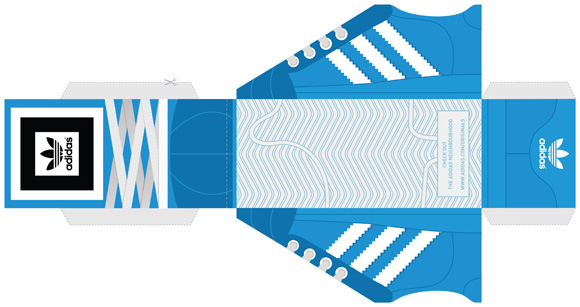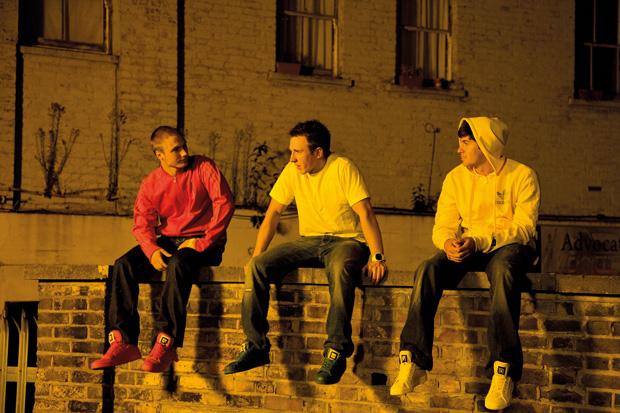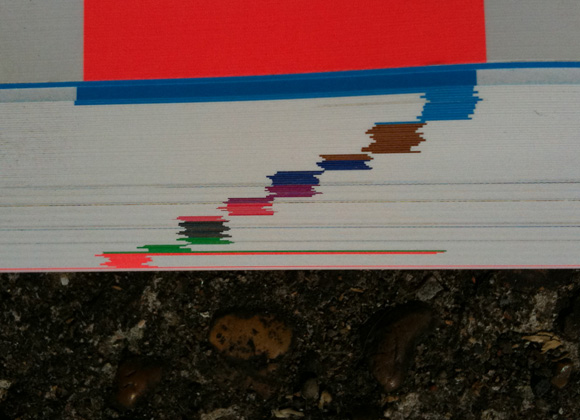Tales of Things, the new service to link digital memories and physical objects has gone online recently. It was covered widely in the media, from the
New Scientist, to
WIRED and
the Guardian, as well as of course on single-blogs
HERE and
HERE. The internet of things has come to life. It is now in your pocket on your iPhone and ready to interact 24/7. How and why this is happening now with this new project out of the ToTeM labs is the question put at the initiators. In this interview
Ralph Barthel, from the developer team behind the service, explains the context and the details of this project.
single-blogs: Tell us something about your background and your role in the project and of course tell us about your most precious tale!Ralph: My research and work background is in the areas of social computing, design research and new media system development with specific applications for learning and knowledge building. In this first phase of the project I was responsible for the development of the backend web application of the Tales of Things service and some aspects of the Interaction Design. In the next few months I will start to explore additional interactions and novel user interfaces to engage with the Tales of Things service.
My first tale on Tales of Things was about an old audio tape recorder (Grundig TK 23) that my grandfather owned. It was built in 1963 and is extremely heavy by today’s standards. Interacting with this thing brings back joyful memories from my youth.
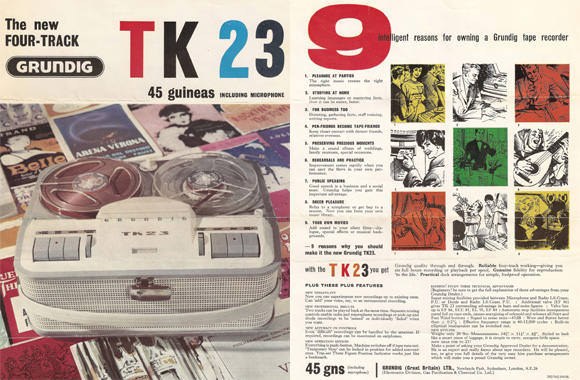 Image taken from TalesOfTings website / The Grundig TK23 documentation from the 60's. Find out more about the Grandfather tale on TalesOfThings.single-blogs: Can you describe the development process of this project.Ralph:
Image taken from TalesOfTings website / The Grundig TK23 documentation from the 60's. Find out more about the Grandfather tale on TalesOfThings.single-blogs: Can you describe the development process of this project.Ralph: In October 2009
Andy Hudson-Smith, the project leader here at CASA, brought
Martin De Jode,
Benjamin Blundell and me together to work on the TOTeM (Tales of Things and Electronic Memory) project. The TOTeM project is funded through a £1.39 million research grant from the EPSRC to explore social memory in the emerging culture of the Internet of Things. Five universities in the UK (Edinburgh College of Art, University College London, Brunel University, The University of Salford and The University of Dundee) are collaborating in this project. The scope of our initial work up to the launch in April 2010 was very much predetermined and detailed by the TOTeM project plan. Consequently we soon started building and evaluating prototypes of our web application and mobile clients with the aim to refine them through formative evaluation with project partners, advisors and selected user groups. In the next phase of this project the Tales of Things service will enable us and our partner institutions to study the relationship of personal memories and old objects when mediated through tagging technologies.
single-blogs: Technical difficulties and special solutions?Ralph: From a technical point of view the main difficulty in an applied project like TOTeM is to leverage the capabilities of broadly available tagging and ubiquitous computing technologies while making them accessible for a large number of people. In this context it is important to go beyond the step of providing a proof of concept (which is the purpose of many research projects) but to create a sustainable and maintainable technological infrastructure for years to come. Within the constraints of a research project with a small technical core team it can be difficult to balance innovation with providing basic support services. This tension cannot readily be resolved and in the next few months also depending on the uptake of the service we will see how this will develop.
single-blogs: In this sense Tales of Things is not a pure research project. What are the aims and who are you working together for the development and for the application (service)?Ralph: The core development team does currently all development work and hosting in-house. Our project partners in Salford are exploring the possibilities of commercialisation. We are planning to collaborate with libraries and museums and to be present Tales of Things technologies at events and festivals. TOTeM will for example be in May in Manchester at the
Future Evertything Festival.
single-blogs: Describe the basic steps to take part in the tales of things project.Ralph: To start people can go to www.talesofthings.com and browse around and have a look at some of the tales that have been already added. They can register on the site for a free account and can download the
iPhone application that reads Tales of Things QR Codes and enables people to create new tales when they interact with a tagged object. After loging in to our web services people can create a new things. To do this they would typically provide some information about the thing such as description and title and a photo of the object if available. In the process of creating a thing they will also be asked to provide a first tale for the thing they are adding. People can then generate and print the QR Codes of their things and comment on other peoples tales of things. The website provides further map views that display where in the world the tales have been created.
single-blogs: The tale is refering to the memory someone has of a thing. As we all know these memories are variable and can be difficult to pin down. Can you describe the strategy you developed to can ephemeral thoughts, what does a tale consist of?
Ralph: A tale starts with a brief textual description and a title of the tale. References to any addressable media for example from services like YouTube, Flickr, Audioboo can be added to a tale. Currently files from the three mentioned services are displayed in an integrated media player interface. All other URL’s are linked as additional resources. Finally a geolocation can be added to a tale.
 Image taken from TalesOfThings / The tale of the Banksy maid in Camden, long gone but still here.single-blogs:
Image taken from TalesOfThings / The tale of the Banksy maid in Camden, long gone but still here.single-blogs: The project has only launched two weeks back on the 17 of April. How was it received and how will you develop the platform in the coming weeks?
Ralph: It was receiving quiet a bit of media coverage for example in the
Guardian Technology blog or
BBC Radio 4. The media feedback was largely positive. There were also some critical voices that doubt that people will socialize around tagged objects. Obviously this is something that time will tell. The media coverage brought some attention to the project and many people visited the website and several hundred already signed up for user accounts.
At this stage we will closely follow how people engage with the Tales of Things service. At this point we are looking for different uses and the values and meaning that people assign to Tales of Things in several pilot studies with different communities. The results from this piloting stage will inform further development efforts. We also aim to support additional mobile platforms such as Android and to develop an API so that other services can connect to Tales of Things.
single-blogs: There are a number of specific terms frequently used to describe aspects of this project. Some are borrowed, some are newly defined and other are everyday words. Can you explain the "thing", the "tale" and the "tag"?
Ralph: A thing refers to any object (e.g. industrial objects, tools, architecture) people would like to link an individual memory to. A tale is story of a personal memory that someone associates with this thing. A tale is told on the platform using different digital media (text, video, images, audio). Video, Image and Audio media can be taken from the web and users can create textual content through our web service. Consequently people can link any addressable digital media file in the creative storytelling process. The thing and the tale(s) are then linked via the tag. This is a unique identifier in the form of an QR Code. This tag is machine readable and can be attached to the thing. The Tales of Things service generates QR Codes for each thing automatically. We also have the option to use RFID identifiers to mark an object. This emerging technology is known for example from the Oystercards. We are curently developing an
Tales of Things RFID reader to further explore the possibilities of this technology. For now any existing RFID tags can be linked to the things in our database.
single-blogs: The project could be classified as being another social networking site. Is it, and if so what is different, or how would you characterize it instead?
Ralph: In the concept of Tales of Things the physical interaction with tagged objects is important. People can only add new tales about things if they physically interact with an object through reading its tag. Certain permissions can only be shared and passed along through the interaction with the object which changes the configuration of the server. While people can view tales of things on our website they can only add new tales when interacting with the tags. Consequently the website, that has elements of social networking sites, is only a part of the entire service experience of Tales of Things. The project aims broader to explore implications of a service space in which enabled through ubiquitous forms of computing physical world and cyberspace are interlinked. The project is interdisciplinary so that the research inquiry includes aspects of Human-Computer Interaction, Art Practise, Anthropology and Commerce.
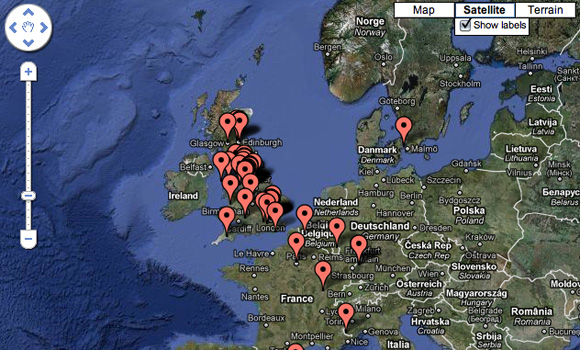 Image taken from talesofthings.com / The World of Things, map on the project site showing the location of the objects and tales. It is also possible to track objects as it loggs each location it was scanned.single-blogs:
Image taken from talesofthings.com / The World of Things, map on the project site showing the location of the objects and tales. It is also possible to track objects as it loggs each location it was scanned.single-blogs: Potential of the internet of things?
Ralph: There is a certain anticipation that the Internet of Things will eventually lead to a technical and cultural shift as societies orient towards ubiquitous forms of computing. The development of technology and practises are often co-evolving so that it is important to understand possible implications. Internet Of Things applications can be complex services that evolve in space and time. The experience of using an Internet of Things service spans several user interfaces and the design space encompasses physical artifacts in the real world as well as conceptual artifacts. Personally I am interested in exploring human-computer interaction (HCI) in this design space as it poses specific methodological, ethical and philosophical challenges that need to be addressed when design IoT applications.
single-blogs: The Internet of Things is not new, why do you think it is emerging just now again?
Ralph: The idea of tagging of things and networked objects is by no means new. What has changed in recent years is that enabling technologies such as internet-enabled smartphones have become more affordable, usable and widespread. More and more people carry powerful small computational devices with them. This has led recently to a renaissance of Internet of Things applications used in a non-industrial context which can be witnessed by services like
Foursquare or
Pachube.
single-blogs: Critical mass for the internet of things to enter as a important player?
Ralph: Internet of Things applications are already important and wide-spread in many industries such a logistics. The TOTeM project is concerned with a different application of the Internet of Things outside industry practise. I can’t say what the critical mass for our project is. The critical mass is not necessarily the most important aspect of the project. It might very well be that the technologies that are developed as part of this project have the potential to add value to the social practises of specific communities. Such findings would be equally important. Tales of Things is after all a research project albeit an applied one.
single-blogs: What is your vision for this project?
Ralph: The partners in TOTeM are from five universities and have different backgrounds and might therefore have different visions. From a research perspective I am mainly interested in studying and exploring the Internet of Things as hybrid interaction design space and how IoT applications can be used for learning and knowledge building in everyday activities. From a long-term perspective it would be great to see a sustained engagement of many people with the Tales of Things service.










